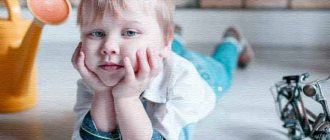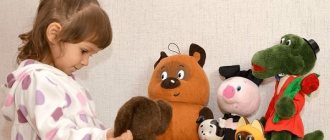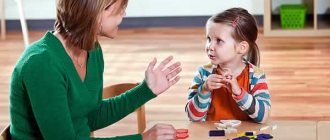Physical development of the child
The main goal is to make the child stronger, more resilient, dexterous, and teach him to coordinate his movements well. Experts recommend doing the following exercises daily:
- stepping over small obstacles;
- walking on an inclined plane;
- jumping over a drawn line (like playing hopscotch);
- walking on a string placed on the floor;
- jumping forward on both legs;
- jumping from low heights.
It is very useful for three-year-old children to swim, dance, play various ball games, ride a bicycle, and perform various exercises on the children's sports wall. Be sure to teach your child to do morning exercises or do fitness with him.
About boys and girls at 3 years old
Already at the age of three, one must begin to instill in the boy “masculine” virtues. Teach him to be kind, strong and brave. At this age, the future man should communicate with his father more often. To follow his example and feel comfortable in male society in the future. Mothers during this period, on the contrary, need to show their “weakness”. Asking your son to open the door or carry a bag.
During this period, mothers need to start making friends with girls. There will be no more suitable age. And the father must show that his daughter can feel protected next to him.
But the main thing is that, despite the whims and quarrels, the three-year-old child continues to feel loved and needed at this time. Only his parents will help him cope with the crisis.
Intellectual and creative development
At three years old, a child actively learns about surrounding objects and phenomena, explores his capabilities, and for this it is necessary to develop attention, logical thinking, memory, and imagination. What exercises will help?
- Search for the desired color by sample or name.
- Collecting nesting dolls, pyramids, molds of different sizes.
- Selection of volumetric and flat squares, circles, triangles and other geometric shapes.
- Games for the difference between the concepts of “small”, “large”, “medium”.
- Folding a picture-riddle: first from 2 two parts, then from 3-4 parts.
- Search for a whole picture by its piece.
- Generalization of objects according to the main characteristic: living-non-living, edible-inedible, etc.
- Game of mosaic, lotto, dominoes.
- Finding matches, for example, shadows and figures.
- Searching for an extra item in a group of other items.
- Adding missing details.
- Reading fairy tales together. If the child knows some letters, ask them to find them in the text.
Take every opportunity to teach your baby something new. For example, during a walk, tell him about trees, animals, phenomena, transport - in a word, about everything that you came across along the way.
The study of elementary mathematical concepts and numbers should take place in a playful way. Ensure that your child not only memorizes the names of numbers, but learns how to determine the number of objects.
To develop creative thinking, experts advise regularly performing the following exercises :
- playing with a construction set, cubes, creating structures based on a model;
- collecting simple puzzles;
- drawing and coloring with paints, pencils, felt-tip pens;
- drawing a variety of geometric shapes, you can use a stencil or pattern;
- modeling simple figures from plasticine, salt dough, clay;
- applications made from natural materials, colored paper and cardboard, magazine clippings;
- cutting along the contour with scissors, etc.
Children aged 3 enjoy playing story games, puppet theater, and participating in simple short dramatizations.
What parents of 3-year-old children need to know
What to do in such cases? First, be patient and understand that the situation cannot be resolved with prohibitions and cursing.
Three years is already a long time
The best way is to switch the child’s attention from a conflict situation to something interesting. You can also occasionally manipulate children's whims. For example, prohibit him from eating porridge or collecting toys.
Mom's and dad's actions should not contradict each other. If one parent prohibits something, the spouse must support him. And vice versa.
During this period it is very important:
- Don't forget to praise your child;
- Show your love;
- Under no circumstances should you brush aside the crumbs.
Speech development
Normally, a three-year-old child speaks about 1000 words well and can already speak well, so special attention should be paid to speech development. What can you do?
- Communicate with your child as much as possible, be interested in what he says.
- Perform articulation exercises daily. This will help you place the speech sounds correctly.
- Discuss the story pictures. A collection of fairy tales by Vladimir Suteev is ideal for classes.
- Learn poems and songs. Poetic riddles are a hit with kids.
Speech development is positively influenced by games and exercises that involve fine motor skills , for example:
- all kinds of games with cereals, beans, buttons, sand, shells, pasta, etc.;
- fastening buttons, lacing;
- finger gymnastics;
- origami;
- games with water.
Musical activities help develop speech hearing: singing, guessing familiar sounds, playing musical instruments, guessing songs, singing vowel sounds.
Communication skills
If your child used to play alone, now the company of his peers is important to him. Children at 3 years old are usually very sociable and outgoing. According to the classification of M.I. Lisina for this age is characterized by an extra-situational-cognitive form of communication. This means that communication most often occurs against the backdrop of joint activities to get to know the world. At the same time, it is very important for a 3-year-old child to feel approval and sympathy from loved ones.
Social development
The development of social skills is especially important if the child does not go to kindergarten for some reason. To do this, encourage play and communication with other kids on the playground in the yard. In addition, teach your baby to be independent:
- give feasible tasks, for example, making the bed, putting away a toy, washing a plate after yourself;
- ask for help when you cook or clean;
- teach how to dress and undress, fasten shoes, neatly fold things;
- introduce the rules of behavior at the table, on the street, in a public place, at a party, etc.
- teach polite words: thank you, please, etc.
Behavior of children of different temperaments
Adults notice that children of the same age can react differently to the same words from their parents. Some will start crying, some will listen calmly, and some will throw a huge tantrum. In fact, each child needs an individual approach, because all people (even the smallest) are different, with their own temperament and character. If you find an approach to a child based on his temperament, you can cope with even the most capricious and problematic children.
If the same approach in education is applied to all children, this is fraught with serious psychological problems in the future. The child will behave inappropriately, show aggression, and personality degradation may occur in the future. The method of our grandparents, when all children could be whipped with a belt and put in a corner, does not work.
Authoritarian, despotic parents do not even try to hear their child, but practically remake him for themselves, breaking his fragile psyche. A person who was abused, humiliated, or beaten by his parents as a child is likely to be addicted to alcohol, nicotine, or illicit drugs. It is difficult for such people to find a common language with others; their personal lives often do not work out.
By the age of 3-4 years, the baby is already beginning to develop his own temperament. Psychologists separate the concepts of “temperament” and “character”. Temperament is a type of behavior that is inherent in a person from birth by nature, and character is formed through upbringing.
There are four types of temperament:
- melancholic;
- sanguine people;
- choleric people;
- phlegmatic.
Temperaments are practically never found in their pure form. Usually in a person there is a mixture of several types, for example, 80% choleric and 20% sanguine. Babies with different types of prevailing temperament react differently to the same situation. The differences are especially noticeable in cases where children do not get what they want.
Melancholic people
Such children require special attention to their person. They react sharply to any comments, and raising their voice at them is tantamount to physical punishment. Melancholic people are very sensitive, they are easily offended and hurt. Under no circumstances should such children be shamed in front of strangers. For melancholic people, even just being among a large number of children and adults is a serious test. That is why adaptation to kindergarten is difficult and painful for them. There is no need to demand any outstanding results; it is enough that the baby is surrounded by strangers.
Sanguines
As a rule, children with a dominant sanguine temperament do not cause parents any special problems. They are almost always in a good mood, without mood swings. If a child is upset about something, he will not throw tantrums and lie on the floor. He interacts well with other children in a group, loves active games, and has no problems sleeping, which has a beneficial effect on the state of the nervous system.
One of the disadvantages of sanguine children is that they are quite cunning. If the baby does not want to do what is asked of him, he will not do it. The main mistake parents make is that they take their child’s word for it and follow his lead. If you ignore this nuance, the baby will grow up to be a deceiver. Parents should raise a sanguine person calmly, without shouting or reproaches, but the child must fulfill their wishes and demands. Also, you should not over-praise the baby, otherwise he may catch the “star” disease. You need to praise for actions and actions, and not just like that.
Very interesting: Is it possible to deceive children: the opinion of psychologists
Cholerics
Always active, running somewhere, grasping at any task, but also quickly giving up. They are highly emotional and often have problems falling asleep. It is very important to raise a choleric child correctly, otherwise he may grow up to be an unbalanced, angry person. The main mistakes of parents:
- aggressive attitude;
- overprotection.
When a little choleric person gets angry and starts playing pranks and destroying the whole house, you need to try to remain calm and not raise your voice. You shouldn’t put pressure, force, or impose your opinion. It is advisable to agree on some things in advance and discuss prohibitions.
Phlegmatic people
Children are not only active and noisy, but also calm and balanced. Phlegmatic people are slow, thoughtful, and love to sleep for a long time and laze in bed. Phlegmatic children perceive information well if it is presented by example. Parents need to be actively involved in raising a phlegmatic child, otherwise he will remain inert.
Parents need to be sensitive and attentive when raising their children.
They must be able to distinguish the reasons why the baby does not listen, and take action in time. Every day, mom and dad build trusting and warm relationships with their children, although sometimes this is difficult. If you take into account the baby’s temperament, educational moments and communication will be much easier for all family members. leave a comment
How to exercise at home?
The developmental lesson should take place in suitable conditions: in good lighting, in a ventilated room. The TV and computer need to be turned off, toys should be put away so that nothing distracts the baby. Make sure your child has had a good night's sleep, is not tired, and is not hungry or thirsty. Try to have your classes regularly, at the same time, because three-year-olds are very sensitive to changes in routine.
If a child refuses to complete the proposed tasks, do not force him, occupy him with something else. After some time, try again, most likely it will be successful.
The concept of the “three-year crisis”
This is a difficult developmental crisis for the baby’s parents. It is accompanied by constant hysterics, manifestations of a developing character.
Main features
The kid answers “no” to all requests, suggestions and questions and insists on his own. At the same time, he refuses to perform actions that he did without problems. The child does not ask for help, easily enters into conflicts, and behaves like a hooligan. Unreasonable jealousy often appears.
Children can be aggressive and disobedient.
Crisis of three years
The three-year crisis is considered the most turbulent in a child’s development, and it is a serious obstacle to regular developmental activities. Negativism, hysterics, stubbornness, ignoring requests, jealousy - you can encounter all this at any time. What to do in this case?
- Change your tactics and ignore the hysteria.
- Give your child more time to recover.
- Provide choice, or the illusion of it.
- Instead of forcing your child, offer help.
- Don't criticize or scold.
If you feel that you cannot cope with yourself and your child, seek the help of child psychologists and early development teachers. Most likely, in an unfamiliar environment the child will begin to behave more calmly. Classes in early development centers are held in small groups of up to 6 people, where children feel comfortable and receive a lot of attention.
Date of publication: 09/24/2018. Last modified: 01/13/2020.
First you need to understand a few moments of the crisis of a 3-year-old child
- Why does the crisis begin?
- What happens to the child?
- What should parents do?
- How to help a boy in a crisis?
- How to help a girl in a crisis?
The crisis will affect all three-year-old children.
As sad as it is, every family has to face a crisis. Even the most flexible and obedient child will change during this period.
Most often, parents at this age are faced with negativism. When a child begins to have a negative attitude towards one of the adults or his request. At this moment, the fidget may even give up his desires, just to do it “out of spite.”
In addition, the three-year-old becomes very stubborn. He begins to quarrel with his parents and try to do everything on his own. Often he becomes uninterested in his old favorite toys.
The crisis lasts up to several months. The main thing that parents should not do:
- Get irritated;
- Punish physically;
- It is also not recommended to indulge a capricious child in everything.
Daily routine and care for a three-year-old child
The baby becomes very active, and it is important to adhere to a daily routine so that the child has enough strength. Of course, the routine of a child who goes to kindergarten will differ from the routine of a child who does not attend preschool, but an approximate daily routine for three-year-olds could be like this:
| 07.00 | Climb |
| 07.30 | Hygiene procedures, exercise |
| 08.00 | Breakfast |
| 08.30 | Educational games and activities, help with everyday life |
| 10.00 | Walk |
| 12.00 | Dinner |
| 12.30 | Daytime nap |
| 15.00 | Awakening |
| 15.30 | Afternoon snack |
| 16.00 | Outdoor and educational games |
| 18.00 | Walk |
| 19.00 | Dinner |
| 19.30 | Quiet activities |
| 20.30 | Hygiene procedures |
| 21.00 | Night sleep |
⠀
Math skills
At 3 years old, children already have some mathematical skills. They must know and be able to:
- count to five forward and backward;
- show the number on your fingers;
- know what numbers from 1 to 5 look like;
- compare the number of objects in different groups using the concepts “more”, “less”, “same”;
- know and be able to draw basic geometric shapes (circle, square, triangle, oval, rectangle);
- recognize the outlines of geometric shapes in various objects (a clock is a circle, a TV is a rectangle).
Some kids already know all the numbers from 0 to 10 and can write them. This is a good help for future preparation for school.
Fine motor skills
The youngest preschooler actively develops and improves fine motor skills. He must be able to:
- hold a pencil, felt-tip pen, or drawing brush correctly;
- trace simple drawings using dots;
- draw geometric shapes, straight and broken lines;
- write familiar block letters;
- use scissors to cut simple shapes from paper;
- shade the drawing in different directions;
- coat the paper appliqué parts with glue and glue;
- sculpt balls and sausages from plasticine and connect them.
There are many finger games for developing a child's fine motor skills.
Logical thinking
At 3 years old, children already have some logical thinking skills. They must be able to:
- combine two objects into a logical pair (“pencil-paper”, “tea-cup”);
- exclude unnecessary items from a group;
- understand the logical sequence of events (clouds gathered in the sky - it began to rain - the ground became wet);
- highlight the main properties of objects and combine them into groups according to these properties;
- understand time sequence (“yesterday”, “today”, “tomorrow”, “now”, “later”);
- distinguish opposites (big - small);
- understand the location of objects in space (“above”, “below”, “above”, “below”).








